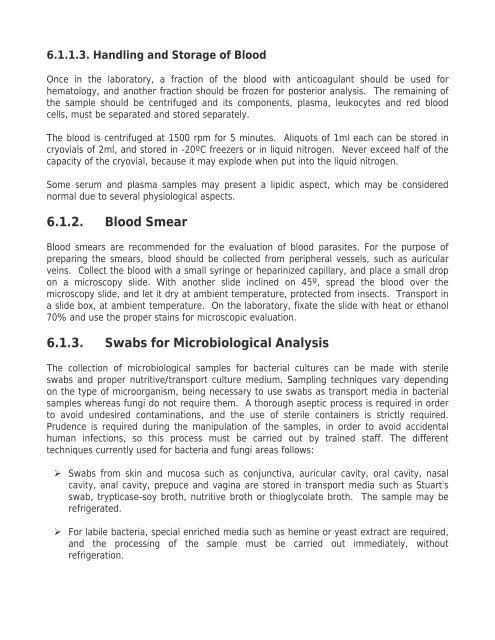TAPIR FIELD VETERINARY MANUAL - Tapir Specialist Group
TAPIR FIELD VETERINARY MANUAL - Tapir Specialist Group
TAPIR FIELD VETERINARY MANUAL - Tapir Specialist Group
You also want an ePaper? Increase the reach of your titles
YUMPU automatically turns print PDFs into web optimized ePapers that Google loves.
6.1.1.3. Handling and Storage of Blood<br />
Once in the laboratory, a fraction of the blood with anticoagulant should be used for<br />
hematology, and another fraction should be frozen for posterior analysis. The remaining of<br />
the sample should be centrifuged and its components, plasma, leukocytes and red blood<br />
cells, must be separated and stored separately.<br />
The blood is centrifuged at 1500 rpm for 5 minutes. Aliquots of 1ml each can be stored in<br />
cryovials of 2ml, and stored in -20ºC freezers or in liquid nitrogen. Never exceed half of the<br />
capacity of the cryovial, because it may explode when put into the liquid nitrogen.<br />
Some serum and plasma samples may present a lipidic aspect, which may be considered<br />
normal due to several physiological aspects.<br />
6.1.2. Blood Smear<br />
Blood smears are recommended for the evaluation of blood parasites. For the purpose of<br />
preparing the smears, blood should be collected from peripheral vessels, such as auricular<br />
veins. Collect the blood with a small syringe or heparinized capillary, and place a small drop<br />
on a microscopy slide. With another slide inclined on 45º, spread the blood over the<br />
microscopy slide, and let it dry at ambient temperature, protected from insects. Transport in<br />
a slide box, at ambient temperature. On the laboratory, fixate the slide with heat or ethanol<br />
70% and use the proper stains for microscopic evaluation.<br />
6.1.3. Swabs for Microbiological Analysis<br />
The collection of microbiological samples for bacterial cultures can be made with sterile<br />
swabs and proper nutritive/transport culture medium. Sampling techniques vary depending<br />
on the type of microorganism, being necessary to use swabs as transport media in bacterial<br />
samples whereas fungi do not require them. A thorough aseptic process is required in order<br />
to avoid undesired contaminations, and the use of sterile containers is strictly required.<br />
Prudence is required during the manipulation of the samples, in order to avoid accidental<br />
human infections, so this process must be carried out by trained staff. The different<br />
techniques currently used for bacteria and fungi areas follows:<br />
� Swabs from skin and mucosa such as conjunctiva, auricular cavity, oral cavity, nasal<br />
cavity, anal cavity, prepuce and vagina are stored in transport media such as Stuart’s<br />
swab, trypticase-soy broth, nutritive broth or thioglycolate broth. The sample may be<br />
refrigerated.<br />
� For labile bacteria, special enriched media such as hemine or yeast extract are required,<br />
and the processing of the sample must be carried out immediately, without<br />
refrigeration.










